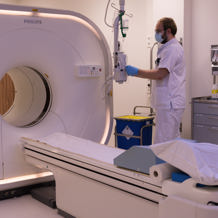Salivary gland cancer
Salivary gland tumors can develop in many different types of glands and aren’t always malignant. See the list below for an overview of the types of glands that can develop a tumor, and the chances of it being malignant:
- Parotid gland: 20% malignant
- Submandibular gland: 50% malignant
- Sublingual gland: 70% malignant
- Small salivary glands in the mouth, nose, and throat cavities: 80% malignant
Find out more about the causes and symptoms, and the most commonly used diagnostic tests and treatment types for salivary gland tumors on this page.
Causes and symptoms
Salivary gland cancer most commonly occurs in men and women past the age of 40. It is currently unknown which factors play a role in its development. Skin cancer can also spread to the salivary glands. Common symptoms of salivary gland cancer are pain, inability to move facial muscles, or swellings in the cheeks, in front of, or under the ear, or under the jaw. Malignant tumors are more likely to cause pain and the inability to move the facial muscles.
 nl
nl
 Nederlands (Nederland)
Nederlands (Nederland)
 English (United States)
English (United States)





